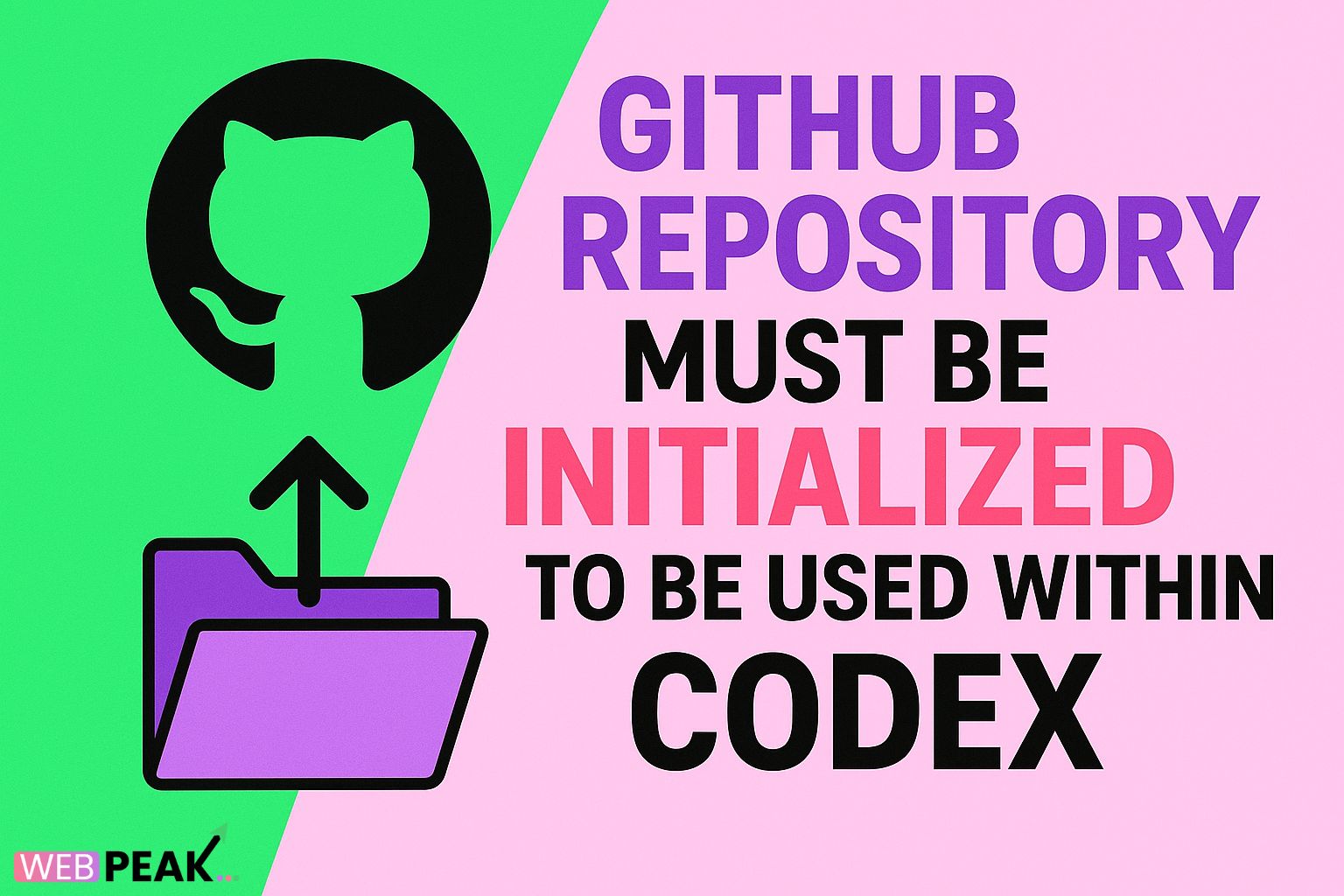Github Repository Must Be Initialized to Be Used Within Codex
When working with GitHub-based workflows—especially AI-assisted development environments—developers often encounter a crucial requirement: a Github repository must be initialized to be used within Codex. Without proper initialization, Codex, GitHub Copilot, and other automation or code-generation tools cannot read, analyze, or interact with the project structure. This is because an uninitialized repository lacks the essential metadata, commit history, and version management foundation that Codex and similar systems rely on to process context, infer patterns, and generate accurate code suggestions. Understanding why repository initialization matters and how to set it up correctly is vital for any development team that wants a seamless AI-supported workflow.
In this article, we break down everything you need to know: what repository initialization means, why Codex depends on it, how to properly initialize your repo step-by-step, common mistakes developers make, and how to optimize your setup for AI-driven development. Whether you're a beginner or building production-grade systems, this guide will help you adopt best practices that improve workflow efficiency and code consistency.
Additionally, if your business needs expert guidance in Web Development, Digital Marketing, or SEO, consider partnering with WEBPEAK—a full-service digital marketing company helping brands build strong digital foundations.
What Does It Mean to Initialize a GitHub Repository?
Initializing a GitHub repository typically means setting up the foundational structure that Git requires to manage files, track changes, and collaborate with others. This includes creating essential components like:
- A
.gitdirectory that stores version history and metadata - An initial commit that establishes the repository baseline
- Configuration files such as
README.md,.gitignore, and licensing files - A branch structure (usually the default
mainbranch)
While GitHub allows you to create a repository without these components, Codex and similar AI tools require the repository to be initialized so they have a context-rich environment to work with.
Why a Github Repository Must Be Initialized to Be Used Within Codex
Codex relies heavily on repository context. It reads file structures, commit messages, language frameworks, and code patterns to generate optimized and relevant suggestions. Without initialization, Codex cannot:
- Access project files or infer the project’s structure
- Analyze commit history or understand code evolution
- Determine the language or frameworks used
- Provide accurate auto-completions or code generation
- Assist with repository-wide search, editing, or automation tasks
In other words, initialization provides the “starting point” Codex needs to function properly.
Common Problems When the Repository Is Not Initialized
1. Codex Fails to Detect Project Files
Without initialization, Codex cannot clone or reference the repository correctly. This often results in incomplete suggestions or errors stating that “no repository context is available.”
2. Limited Code Understanding
Codex depends on structured commit history. If the repository has no commits, the model cannot infer coding patterns, architecture decisions, or naming conventions.
3. Errors Running Git Commands
Commands like git push, git status, and git branch will fail if Git is not properly initialized.
4. Continuous Integration and Deployment Issues
CI tools (GitHub Actions, Jenkins, etc.) require an initialized repository to run pipelines. Without commits, workflows cannot trigger correctly.
How to Properly Initialize a GitHub Repository (Step-by-Step)
Below is the recommended workflow to initialize your repository correctly for Codex and other tools.
Step 1: Create a New Repository on GitHub
- Go to GitHub
- Click New Repository
- Enter repository name and description
- Select visibility (public or private)
- Add initialization files:
README.md.gitignore(optional but recommended)- License file (optional)
- Click Create Repository
Step 2: Clone the Repository Locally
git clone https://github.com/yourusername/yourrepo.git cd yourrepoStep 3: Add Your Project Files
Add your existing project code or begin building your application inside the repository folder.
Step 4: Stage and Commit Your Changes
git add . git commit -m "Initial project setup"Step 5: Push the Commit to GitHub
git push origin mainYour repository is now fully initialized and ready for Codex.
Optimizing Your Repository for Codex
Use Clear and Descriptive Commit Messages
Codex learns from commit history. Descriptive messages give AI better context when providing suggestions.
Structure Project Files Properly
- Organize files into folders (e.g.,
src,assets,tests) - Use naming conventions consistently
- Document your architecture in a
README.md
Include a .gitignore File
This prevents unnecessary files (like logs or environment variables) from being tracked and confusing Codex.
Add a Comprehensive README
Include:
- Project purpose
- Tech stack
- Installation instructions
- Usage instructions
- API references (if applicable)
Codex uses README content to infer project intentions and provide better suggestions.
Use a Standard Branching Strategy (e.g., GitFlow)
This helps Codex differentiate between development stages and understand the workflow logic.
SEO Checklist: Optimizing Your GitHub Repo for Search Engines and Codex
- ✔ Add a readable and keyword-rich
README.md - ✔ Include repository topics and descriptions on GitHub
- ✔ Use consistent file naming conventions
- ✔ Document API endpoints in markdown files
- ✔ Add internal links between documentation files
- ✔ Create structured folders for clean scanning
- ✔ Use semantic markdown headings (H1–H3)
- ✔ Keep commit messages descriptive and informative
- ✔ Ensure the repository is public if intended for SEO indexing
- ✔ Provide example code snippets in documentation
Frequently Asked Questions
1. Why must a GitHub repository be initialized before using Codex?
Codex requires a structured repository with history, files, and metadata to interpret the project and generate relevant code suggestions. Initialization provides that foundation.
2. Can I use Codex with an empty repository?
No. Even an empty repository must be initialized with at least one commit for Codex to work effectively.
3. What files should I include during initialization?
At minimum: README.md, .gitignore, and an initial commit. Adding a license file is also recommended.
4. Will Codex work if the repository is private?
Yes, as long as you authorize Codex or connected tools to access your private repository.
5. Does the default branch name matter?
Codex supports any branch name, but using main is recommended for consistency and compatibility with automation tools.
6. What happens if I forget to initialize my repository?
Codex may fail to load project context, provide incomplete suggestions, or be unable to access your files. Initializing resolves these issues.
7. Can I initialize a repository after adding files?
Yes. You can initialize with git init and then commit your files at any time.
8. Does the repository structure affect Codex performance?
Absolutely. A well-organized repository enables better analysis, faster suggestions, and more accurate code predictions.
9. How many commits are needed for Codex to work efficiently?
You need at least one commit for basic functionality, but multiple descriptive commits improve Codex's contextual understanding.
10. Should I add documentation before or after initializing?
Add documentation before the first commit so Codex can read it immediately once the repository is initialized.
Final Thoughts
A GitHub repository must be initialized to be used within Codex—not just as a technical requirement, but as a best practice for streamlined and intelligent development workflows. Proper initialization creates a structured, context-rich environment that empowers Codex and other AI tools to deliver accurate, optimized suggestions. Whether you're starting a personal project or building enterprise-level applications, initializing your repository correctly ensures smooth collaboration, clean versioning, and a foundation for automation and AI-powered coding.





